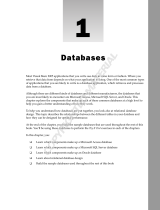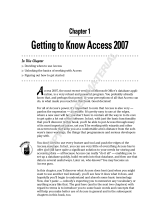
system. Note that since this database serves as the template for any other database, it’s a required
database and must be left on the system; you cannot delete it.
There are several things to keep in mind when altering the model database. First, any database you cre-
ate has to be at least as large as the
model database. That means that if you alter the model database to
be 100MB in size, you can’t create a database smaller than 100MB. There are several other similar pitfalls.
As such, for 90 percent of installations, I strongly recommend leaving this one alone.
The msdb Database
msdb is where the SQL Agent process stores any system tasks. If you schedule backups to run on a
database nightly, there is an entry in
msdb. Schedule a stored procedure for one time execution, and yes,
it has an entry in
msdb.
The tempdb Database
tempdb is one of the key working areas for your server. Whenever you issue a complex or large query
that SQL Server needs to build interim tables to solve, it does so in
tempdb. Whenever you create a tem-
porary table of your own, it is created in
tempdb, even though you think you’re creating it in the current
database. Whenever there is a need for data to be stored temporarily, it’s probably stored in
tempdb.
tempdb is very different from any other database in that not only are the objects within it temporary, but
the database itself is temporary. It has the distinction of being the only database in your system that is
completely rebuilt from scratch every time you start your SQL Server.
Technically speaking, you can actually create objects yourself in tempdb — I strongly recommend
against this practice. You can create temporary objects from within any database you have access to in
your system — it will be stored in
tempdb. Creating objects directly in tempdb gains you nothing but
adds the confusion of referring to things across databases. This is another of those “Don’t go there!”
kind of things.
AdventureWorks
SQL Server included samples long before this one came along. The old samples had their shortcomings
though. For example, they contained a few poor design practices. (I’ll hold off the argument of whether
AdventureWorks has the same issue or not. Let’s just say that AdventureWorks was, among other
things, an attempt to address this problem.) In addition, they were simplistic and focused on demon-
strating certain database concepts rather than on SQL Server as a product or even databases as a whole.
From the earliest stages of development of Yukon (the internal code name for what we know today as
SQL Server 2005) Microsoft knew they wanted a far more robust sample database that would act as a
sample for as much of the product as possible. AdventureWorks is the outcome of that effort. As much
as you will hear me complain about its overly complex nature for the beginning user, it is a masterpiece
in that it shows it
all off. Okay, so it’s not really everything, but it is a fairly complete sample, with more
realistic volumes of data, complex structures, and sections that show samples for the vast majority of
product features. In this sense, it’s truly terrific.
I use it as the core sample database for this book.
4
Chapter 1
04_584340 ch01.qxp 10/18/06 2:11 PM Page 4
























